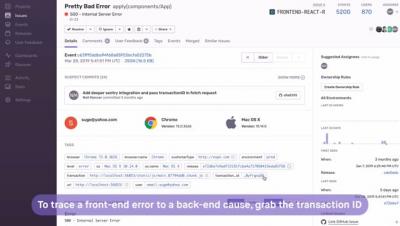Operations | Monitoring | ITSM | DevOps | Cloud
Sentry
Surface Kubernetes Errors with Sentry
Kubernetes, like a lot of other tools, can be noisy. Errors and warnings often go completely unnoticed in the event stream. Or sometimes they are noticed, but are hard to understand in the context of what else is happening in the cluster. Sentry, unlike a lot of other tools, works to eliminate that noise as much as possible, including Kubernetes-related noise.
Common Sentry Settings Roadblocks and How to Overcome Them
Sentry helps developers monitor and fix crashes in real-time. Of course, finding and fixing bugs with Sentry is easier when Sentry itself is set up in a way that minimizes disruption. Our help center and documentation can help with that. We’ve also put together a list of the most common issues our Support team works on with Sentry customers that you’ll find useful (or, at least we hope you do).
Growing Adoption by Building a Modern Clippy
Remember Microsoft’s trusty assistant, the annoying/endearing Clippy? We built something similar for the modern web, minus the annoying parts, and discovered that, if done right, it can increase user engagement and success with your product.
Trace Errors Through Your Stack Using Unique Identifiers in Sentry
Imagine, you dear reader, have an e-commerce website (it’s 2019, after all) where you sell artisanal hot dogs. This site is built on several services that talk to each other to make sure your customers can easily purchase their organic, grass-fed hot dogs.
Exception Perceptions: Gremlin + Chaos Engineering
On this episode of Exception Perceptions, Tammy Butow, Principal SRE at Gremlin and creator of the popular O’Reilly Chaos Engineering Bootcamp, helps us organize our thoughts on Chaos Engineering. Watch the episode, and read more of Tammy’s suggested practical ways to perform Chaos Engineering. Then go and get all of her Chaos Engineering resources.
Fixing Sentry with Sentry: Lock-Contention Edition
Sentry recently experienced two minor outages related to database lock-contention: a situation where a process stops executing as it waits on another to release a shared resource they each depend on. It’s kind of like [insert comical metaphor intended to inspire a light-hearted chuckle here].
Maximize Insights with Sentry's Integrations
We recently released a new set of features that increase visibility into errors across your organization. These features are great and helpful, and you should definitely be using them right now. That said, we also want to remind you of great and helpful integrations that also maximize visibility into your errors.











